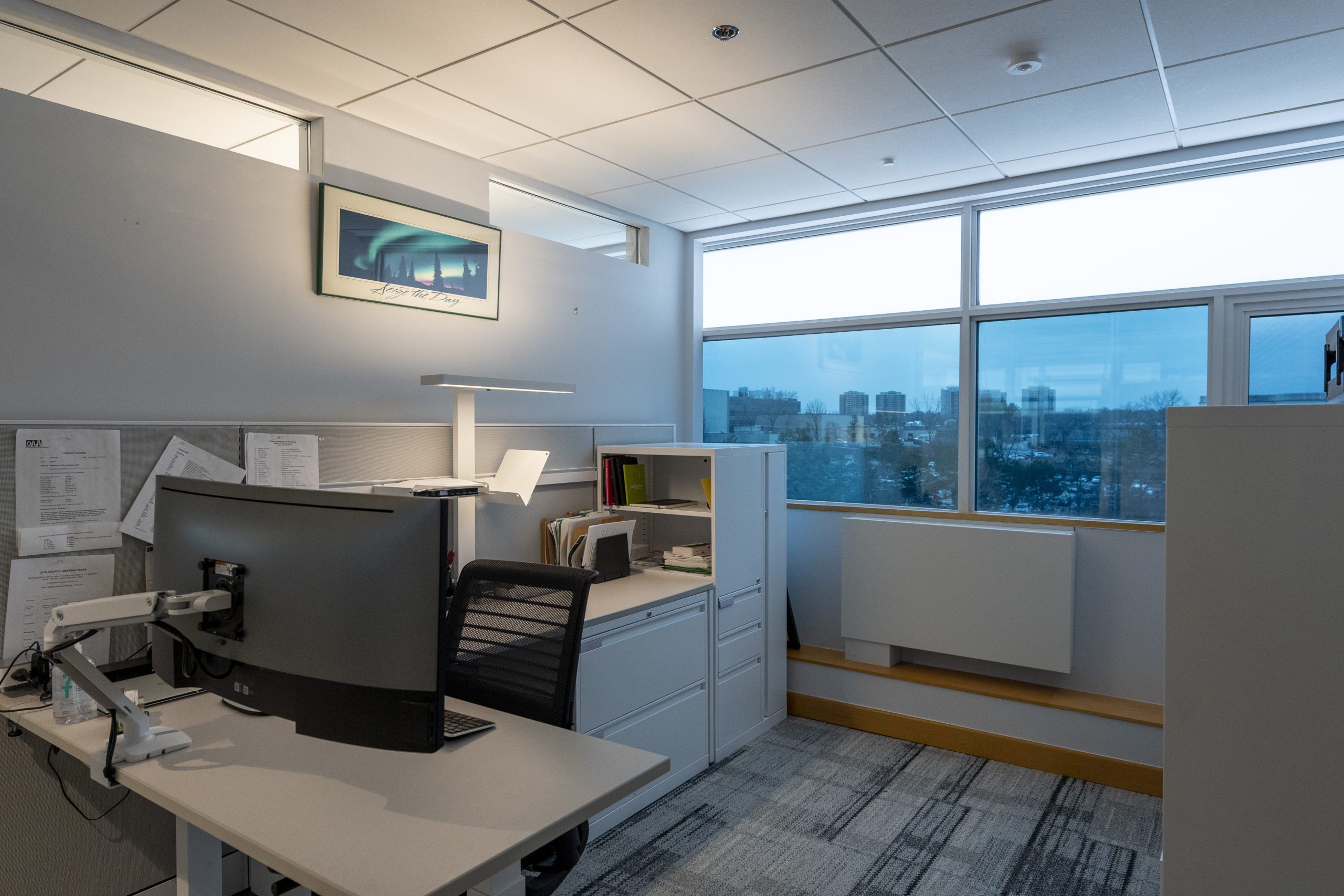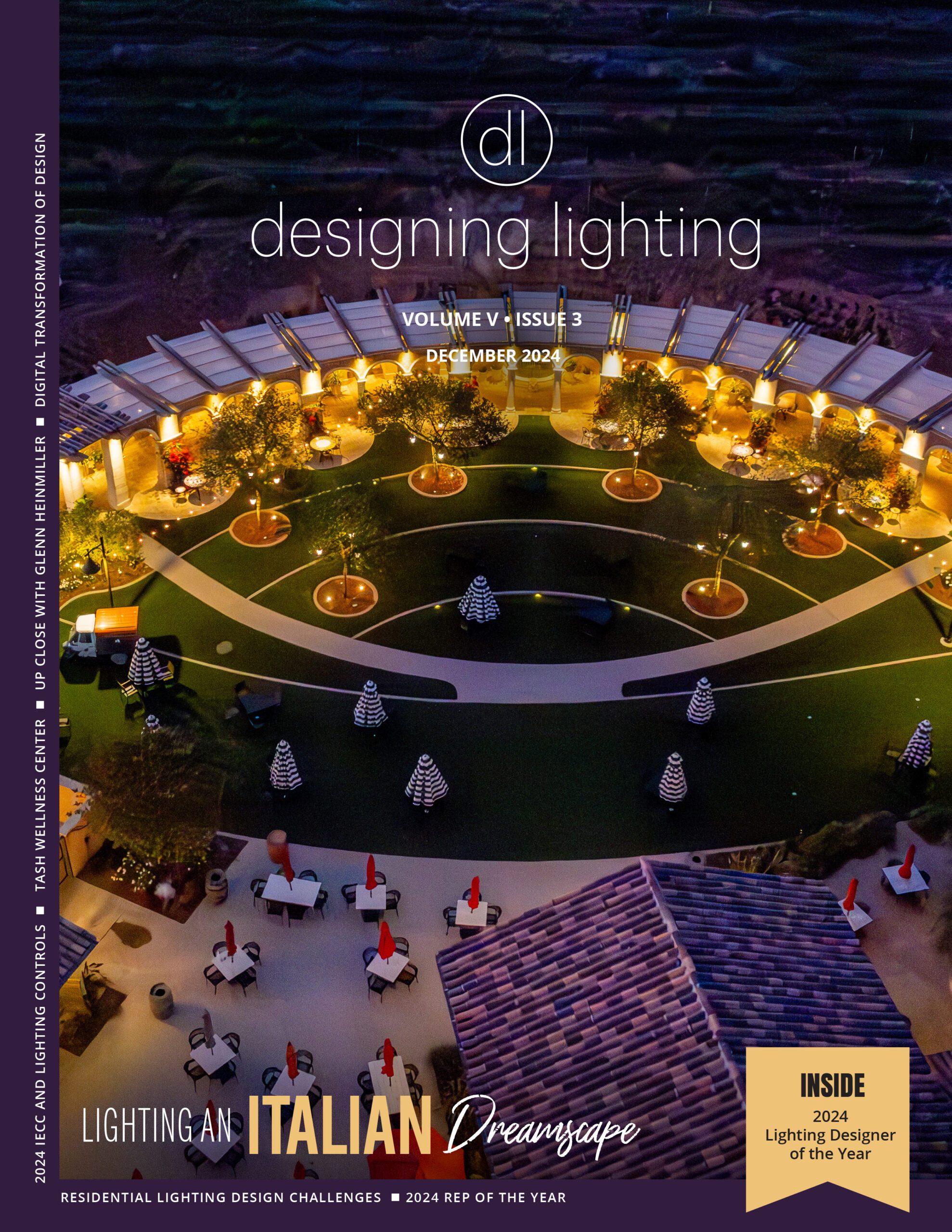Imagine creating a lighting design for an association whose 7000 members all know a little something about lighting. The team at Gottesman Associates did just that for the Ontario Association of Architects’ headquarters building.
The OAA was founded in 1889 as a regulatory body for architects in the province of Ontario, Canada. This organization is dedicated to regulate, promote and educate its membership, who include 4300 architects, 1716 international architects, and 819 students, licensed technologists, and retired and honorary members.
In 1989, the OAA organized an international juried competition that was won by a young, local architect, Ruth Cawker. Her six million (Canadian) dollar design was completed in 1992. Two decades later the building needed significant work and there was discussion about whether they should sell, relocate or renovate the building. After an intensive investigation, the OAA made the decision to renew and refresh the existing headquarters.

The original design of the building has a high window to wall ratio of 60%, providing ample daylight and beautiful views of the adjacent greenbelt. The structure appears to float in air as parking is on the first floor and the building is occupied on the second and third floors above. The main work spaces consisted of private offices around the perimeter, anchored by a central day-lit atrium, and meeting rooms. While architecturally pleasing, the high window to wall ratio and exposure on all six sides made thermal control challenging.

The headquarters had no sun control or redirecting strategies except for some roller shades. Most of the shades were permanently closed and workers were dependent on end-of-life fluorescent and CFL luminaires for their light. Around the perimeter of the atrium, direct sunlight exposure created glare and heat. Resourceful employees installed commercial outdoor umbrellas above their desks to block the uncomfortable effects of sunlight.
The OAA’s “Renew and Refresh” initiative was a complete renovation that was targeting net-zero as part of The 2030 Challenge, by 2020. They would make the process completely transparent to their membership, including full access to financial and design documents. As part of the major renovation, the OAA hired Gottesman Associates for the daylight study and lighting design, with the following objectives:
- To leverage daylight and mitigate glare,
- To create a quality visual environment for enhanced uses of space,
- To honor the existing architecture, and
- To be a benchmark for design.
“As if this wasn’t a big enough mandate, there was the added pressure of working for all the architects in the province of Ontario!”, said Deborah Gottesman, Principal of Gottesman Associates. The team at Gottesman began an integrated, iterative and collaborative process working with the client and members of the design team. First, the study was to explore how much free light from the sun was available, modeling different configurations. For example, they had to find the optimal balance of window Visual Transmission (VT). Higher optical transmission depends on higher VT, which means more light can penetrate the glass but so can heat. Thermally, they wanted lower VT, but for lighting, they wanted higher VT. Ultimately, the study revealed that the desired lower VT windows had a minimal effect on the daylight factors, meaning there was no material effect on the delivered lumens.
Architectural interventions would also impact daylight penetration. Different interior space layouts were modeled, as was the configuration of the new photovoltaic (PV) panels stretching across the roof. The PV could be arranged in different configurations, each with a unique effect on the available daylight. A PV array with gaps between panels was preferred to a fully opaque layout, allowing partial daylighting autonomy in affected spaces.
With the amount of available daylight established, the modeling then focused on finding the sources of glare so they could be mitigated. Shading and glazing are effective options to overcome this problem, as the best approach is to stop the heat before it enters the building, particularly during the summer months. Since the sun is at a lower angle in the winter, there is deeper penetration; that was not a problem as the sunlight is usually welcomed on cold, dark, winter days. But what to do in the summer? Natural shading, like using Hops (a climbing seasonal plant), was considered. Hops can grow to 40 ‘ tall in a season, with large, thick foliage it is able to shield direct daylight in summer months, and then dies back in winter allowing the light inside. Ultimately, adding any shading to the exterior of the building was abandoned for many reasons, including the severe architectural impact of exterior shielding, that forced the search for solutions in other directions.
“The task lights at the desks supplement the light level sufficiently at night to suit paper tasks, if required.”
― Deborah Gottesman
The team then considered less visually intrusive solutions: interior redirecting devices, windows with internal diffusing materials or louvers, window films, and electrochromic and electrothermic windows. Ultimately, a mix of electrochromic windows, daylight redirecting film, and fritted windows provided the right blend of solutions to meet the project objectives. With the seven rounds of daylight modeling completed, what impact did it have on electrical lighting design? First, with the sun providing ample usable light around the building perimeter, the quantity of luminaires required was dramatically reduced, saving 10% of the luminaire budget. “That savings alone paid for our design fees, and the icing on the cake is that the client has ongoing savings in operations and maintenance from fixtures that were never needed, purchased or installed,” explained Deborah. “The task lights at the desks supplement the light level sufficiently at night to suit paper tasks if required.” Vacancy sensors under the desks ensure tasks lights are only used when the occupant is at their desk.

“Staff and the membership have seen a dramatic improvement in their use of the space, where the lighting matches the functionality. Now, the OAA has an upgraded low maintenance system that is easy to operate.”
― Deborah Gottesman

Mindful of accessibility for future maintenance, the new lighting design optimized the complicated structure, revealing interesting features and characteristics. Many luminaires are integrated and concealed from view providing glare-free, magical lighting effects. Indirect lighting is a theme used throughout. It floats the building above the ground floor parking, exposes the volume of the 30’ high atrium, provides flexibility in meeting and council rooms, and delivers comfortable, glare free, ambient light in offices and at reception.
Where visible, a strong rectilinear fixture vocabulary is used, with the exception of the arced luminaires designed to fit perfectly in the curved glass feature stair. Pendant luminaires harmoniously reinforce the building form and create a beautiful ambiance. RGB lighting drapes the edge of the ceiling on the 2nd floor that brighten the ceilings for a voluminous and playful effect.
Lighting controls include daylight harvesting, vacancy sensing, and light level tuning. After rigorous commissioning, the resulting average operating lighting load is ~.1W/sf, ~75% reduction in consumption compared to pre-renovation, and well below applicable local codes.
There are other more qualitative results that Deborah pointed out. “The aesthetic improvements are dramatic, and jive with the architecture; one member repeatedly comments that the interior fit out completes the building! Staff and the membership have seen a dramatic improvement in their use of the space, where the lighting matches the functionality. Now, the OAA has an upgraded low maintenance system that is easy to operate.”
Overall, this has been a leadership project, that the design team and the entire membership of the OAA can be proud of.
Original Architect: Ruth Cawker; Renew and Refresh Architect: David Fujiwara Architect; Electrical Engineering: WSP Toronto; Photography: Michael Tenaglia, Michael T Photography and Design
This article was originally featured in the October issue of designing lighting (dl).



